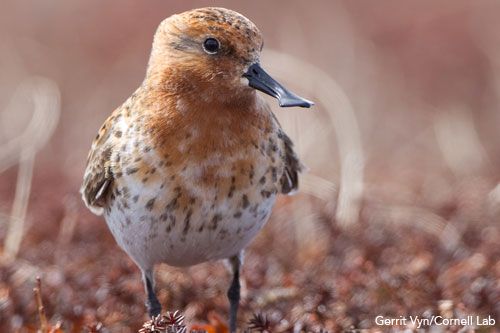
Rare Video: Endangered Chicks Emerge from Nest

This could be the first and last high-definition video of a Spoon-billed sandpiper chick emerging from its nest.
One of the world's most critically endangered species, the 6-inch-tall (15 centimeters) bird faces extinction within 10 years, according to a statement from the Cornell Lab of Ornithology, which released the video. Only about 100 pairs were counted at its breeding grounds in the Russian Far East last year, and the population has declined 25 percent annually in recent years. (There were also 100 juveniles.)
The Cornell Lab sent videographer Gerrit Vyn to Chukotka, Russia, to document the sandpipers' sounds and behavior at a remote nesting site in 2011. The lab recently released the videos online to draw attention to the species' plight.
"The Spoon-billed sandpiper is one of the most remarkable little birds on Earth, and it may go extinct before most people even realize it was here," John Fitzpatrick, executive director of the Cornell Lab of Ornithology, said in the statement. "We hope that with this priceless video footage we quickly connect people, conservation organizations and governments to these amazing birds, and galvanize an international conservation effort."
First moments of life
One video captures the first moments of life as the tiny, fluffy, brown-and-white chicks stumble out of the nest, pecking for food. "They feed themselves from day one," Vyn said in the video. [Watch the chick hatching.]
Vyn camped out a tent and a blind, with only a sleeping bag for warmth, waiting for the eggs to hatch. "It was an incredibly exciting time for me, exciting and nerve-wracking waiting for three days in this windstorm for these four eggs to hatch," he said. Vyn filmed the only nest with eggs in 2011: The other 20 eggs were bred in captivity and the chicks released in Russia to make their 4,971-mile (8,000 kilometer) migration to Southeast Asia.
Sign up for the Live Science daily newsletter now
Get the world’s most fascinating discoveries delivered straight to your inbox.
Much of the little bird's decline is due to habitat loss from development and subsistence hunting along its migratory path and winter home in Southeast Asia seacoasts, scientists think. For example, the 20-mile-long (32 km) Saemangeum seawall in South Korea cut off 170 square miles (440 square km) of estuary and tidal flats, feeding grounds for hundreds of thousands of migratory birds and a primary stopping site for Spoon-billed sandpipers. And shorebirds are a food source for people living along the coastal mudflats of Myanmar and other nearby countries, the Cornell Lab said in a statement.
Documenting a disappearing species
Common foraging behaviors here on the breeding grounds are surprisingly different from the way they feed on the wintering grounds, according to the Cornell lab. On the breeding grounds, the birds feed on insects, especially midges, mosquitoes, flies, beetles and spiders, as well as grass seeds and berries. On the wintering grounds and during migration, they eat marine invertebrates, including polychaete worms and shrimp.
Another video by Vyn shows a mated Spoon-billed sandpiper pair foraging along the edge of a snowmelt pond in Chukotka.
Vyn also captured rarely seen courtship behavior between adult Spoon-billed sandpipers. This video, shot during the first few days of a pair's seasonal courtship, includes an attempted copulation and a nest scrape display.
The Spoon-billed Sandpiper population in Russian has been tracked since 1977, when a survey estimated 2,500 breeding pairs in Chukotka. By 2003 the population had dropped to around 500 pairs. In 2008, the International Union for the Conservation of Nature listed the species as critically endangered on its Red List.
Reach Becky Oskin at boskin@techmedianetwork.com. Follow her on Twitter @beckyoskin. Follow OurAmazingPlanet on Twitter @OAPlanet. We're also on Facebook and Google+.












